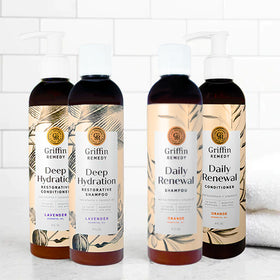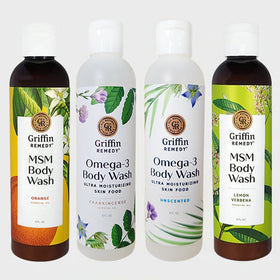
9 Tips to Protect Your Skin During the Summer
Love—and fear—the sun? Welcome to the club: we’re all confused. In a survey by the American Academy of Dermatology, 75 percent of Americans said they would do anything possible to prevent skin cancer. Yet fewer than half of Americans use sunscreen regularly. And sunscreen may not be the panacea we’d hoped. While the use of sunscreens and blocks has increased dramatically since the 1980s, skin cancer rates are higher than ever.
Some researchers suggest that we’ve gone too far in fearing the sun. While it’s true that overexposure to the sun can damage the eyes, contribute to premature aging, and increase the risk of skin cancer, a healthy dose of sunlight also enhances overall mood and promotes the production of melatonin, a natural hormone that improves sleep and slows the aging process.
Sun exposure also prompts the body to produce vitamin D, which supports immune function, maintains healthy bones, enhances cardiovascular health, and protects against cancer. But sunscreens can reduce the body’s production of vitamin D by as much as 99 percent, and some studies suggest that by diminishing vitamin D levels, sunscreens are ironically increasing skin cancer risk. Moreover, studies show that vitamin D supplements aren’t a substitute for vitamin D produced by the body in response to sunlight. And while the American Academy of Dermatology says there’s no safe exposure to the sun, some researchers say that the benefits of natural vitamin D are so great that “the message of sun avoidance must be changed to acceptance of non-burning sun exposure.” In general, you’ll need 15–30 minutes of midday sun several times a week to ensure for the body’s vitamin D needs.
How to optimize vitamin D levels and the benefits of the sun, while minimizing aging, skin damage, and cancer risk?
1. Cover your skin with UPF-rated clothing.
To protect your skin, skip the skimpy bikini and choose lightweight coverups that help filter sun’s damaging rays. UPF (ultraviolet protection factor)-rated clothing is ideal, especially if you’re engaged in summer sports or spending time in the water. Or choose simple clothing in bright colors. In general, the darker or more vivid the color, the greater the protection, but even light-colored fabrics can minimize burns. And wear a hat; a big, wide-brimmed one protects face, neck, and eyes.
2. Protect your eyes by wearing hats and sunglasses.
Too much exposure to UV light can damage the eye and increase the risk of cataracts, growths on the eyes, and even ocular melanoma, a type of eye cancer. Sun damage can happen at any time of year, not just summer. To protect your eyes, wear wide-brimmed hats and sunglasses, even when you’re napping (the thin layer of skin on the eyelids won’t protect your eyes from the sun). The American Optometric Association recommends shades that screen out 75–90 percent of visible light and offer 99–100 percent protection against UVA and UVB rays. The frames should fit close to eyes and contour to the shape of your face to prevent exposure to UV rays from all sides. Wraparound styles are best.
3. Use water-resistant, broad-spectrum sunscreen.
The best kind of sunscreen is water-resistant with broad-spectrum protection against both UVA rays (the ones that age skin) and UVB rays (the ones that burn). An SPF of 30 is best; ultra-high SPF products only filter out about 1 percent more UV light.
There are essentially two kinds of sunscreen: chemical and physical/mineral. Chemical sunscreens use ingredients such as oxybenzone and avobenzone to absorb UV rays. The problem: some of these chemicals are potential endocrine disruptors, and a recent study in JAMA found that four of them—avobenzone, oxybenzone, ecamsule, and octocrylene—enter the bloodstream at levels high enough to trigger a government safety investigation after just one day of use. An FDA update in February noted that chemical sunscreen ingredients needed more research before they could be generally regarded as safe.
On the other hand, physical sunscreens contain zinc oxide or titanium dioxide, minerals that sit on the surface of the skin and act like a shield to deflect the sun’s rays, rather than being absorbed by the body. The FDA’s new sunscreen regulations say only zinc oxide and titanium dioxide are generally recognized as safe and effective. Choose a natural formula that’s free of parabens, petrochemicals, synthetic fragrances, and other potentially harmful chemicals.
4. Stay in the shade.
A beach umbrella, covered pavilion, or even a big, shady tree can protect skin from sun damage and aging—especially if you’re lounging by the pool with a paperback. If you’re more inclined toward volleyball, hiking, or other summer activities, take frequent shade breaks, especially between the hours of 10 a.m. and 2 p.m., when sun’s rays are the most intense. But also know that UV rays are reflected off pool water, sea foam, sand, and even concrete—so you can still burn in the shade. And don’t be fooled by an overcast day: up to 80 percent of UV rays still pass through clouds.
5. Eat foods that protect the skin against damage.
Certain foods minimize sun damage and protect against UV rays. The best:
- Green tea is rich in polyphenols that inhibit skin cancer; topical green tea also has a protective effect.
- Cruciferous vegetables such as broccoli, kale, cabbage, and arugula mitigate oxidative damage to the skin from sun exposure.
- Peppers, strawberries, broccoli, and citrus fruits are high in vitamin C to help protect against skin damage from the sun.
- Tomatoes, papaya, watermelon, pink grapefruit, and persimmons contain lycopene, which protects against the development of UV-induced cancer and may also reduce the risk of sunburn.
- Olives contain oleuropein, a compound that helps protect against sun-induced skin damage and cancer.
- Red cabbage, blueberries, and red onions are rich in anthocyanidin antioxidants that inhibit skin damage and cancer from UV exposure.
- Carrots, mangos, sweet potatoes, and dark leafy greens are high in beta carotene to protect skin cells from UV damage.
6. Choose cosmetics with sunscreens.
Sunscreens aren’t just for poolside or beach vacations. Look for cosmetics laced with sunscreen for all-day, every-day protection. To protect your face from dark spots, wrinkling, and other signs of aging, apply a layer of SPF-fortified lotion and pat an SPF eye cream around eyes; focus on the outer corners where crow’s feet begin, and don’t forget the area just under brows—especially susceptible to burning and damage. Then choose a sunscreen-fortified foundation or use a tinted SPF moisturizer or brush-on powdered bronzer. And keep delicate lip skin from burning with an SPF balm.
7. Treat burns promptly.
If, in spite of your best efforts, you still end up burned, act fast. Get out of the sun the second you notice skin getting pink or red, and hop into a cool shower or bath to minimize redness. Then slather on moisturizer to trap water in skin and ease dryness. Look for products with aloe vera. Studies show that it delays progressive damage, accelerates healing, and reduces inflammation. Keep aloe vera gel in the fridge for instant cooling relief. Lavender oil and calendula have also been shown to reduce inflammation and promote healing.
8. Take supplement to reduce skin damage.
Certain nutrients can protect your skin from damage:
- Omega-3 fatty acids inhibit COX-2 (a chemical that promotes skin cancer progression), reduce DNA damage that can lead to skin cancer, and protect against signs of aging, wrinkle formation, and thinning of skin from UV exposure.
- Polypodium leucotomos, an extract from ferns, can reduce UVA-related damage and protect against wrinkling, brown spots, sunburn, and skin cancer.
- Pycnogenol, extracted from French maritime pine bark, significantly improves skin hydration and elasticity and can combat hyperpigmentation from excessive sun exposure.
- Vitamin E prevents free-radical damage, has anti-inflammatory actions, and protects against UV-related skin damage. It’s especially effective when combined with vitamin C.
- Selenium has been shown to reduce cancer cell progression in several cancers, including skin cancer.
9. Use sunscreens the right way.
Even the best sunscreen won’t work if you don’t apply it properly or often enough. Use enough to generously coat all exposed skin, and apply about 20 minutes before you head outside, especially if you’re using a chemical sunscreen—they need time to be absorbed into the skin to work. Don’t forget sensitive or hard-to-reach areas such as lips, the tops of your ears, around the eyes, the backs of your legs, and even your scalp (especially if your hair is parted or thinning). No matter what the SPF, reapply your sunscreen every two hours—more often if you’re swimming or sweating, even if you’re using a water-resistant formula. They’re just that: resistant, not waterproof (the FDA banned the terms “waterproof” and “sweat-proof” from sunscreens).




